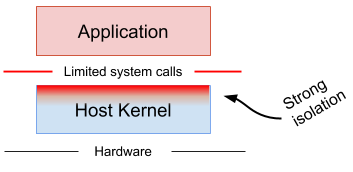How to deploy CRI-O with gVisor?
In this post I will show you how you can install and use gvisor engine in kubernetes.
Parts of the K8S Security Lab series
Container Runetime Security
- Part1: How to deploy CRI-O with Firecracker?
- Part2: How to deploy CRI-O with gVisor?
- Part3: How to deploy containerd with Firecracker?
- Part4: How to deploy containerd with gVisor?
- Part5: How to deploy containerd with kata containers?
Advanced Kernel Security
- Part1: Hardening Kubernetes with seccomp
- Part2: Linux user namespace management wit CRI-O in Kubernetes
- Part3: Hardening Kubernetes with seccomp
Network Security
- Part1: RKE2 Install With Calico
- Part2: RKE2 Install With Cilium
- Part3: CNI-Genie: network separation with multiple CNI
- Part3: Configurre network wit nmstate operator
- Part3: Kubernetes Network Policy
- Part4: Kubernetes with external Ingress Controller with vxlan
- Part4: Kubernetes with external Ingress Controller with bgp
- Part4: Central authentication with oauth2-proxy
- Part5: Secure your applications with Pomerium Ingress Controller
- Part6: CrowdSec Intrusion Detection System (IDS) for Kubernetes
- Part7: Kubernetes audit logs and Falco
Secure Kubernetes Install
- Part1: Best Practices to keeping Kubernetes Clusters Secure
- Part2: Kubernetes Secure Install
- Part3: Kubernetes Hardening Guide with CIS 1.6 Benchmark
- Part4: Kubernetes Certificate Rotation
User Security
- Part1: How to create kubeconfig?
- Part2: How to create Users in Kubernetes the right way?
- Part3: Kubernetes Single Sign-on with Pinniped OpenID Connect
- Part4: Kubectl authentication with Kuberos Depricated !!
- Part5: Kubernetes authentication with Keycloak and gangway Depricated !!
- Part6: kube-openid-connect 1.0 Depricated !!
Image Security
Pod Security
- Part1: Using Admission Controllers
- Part2: RKE2 Pod Security Policy
- Part3: Kubernetes Pod Security Admission
- Part4: Kubernetes: How to migrate Pod Security Policy to Pod Security Admission?
- Part5: Pod Security Standards using Kyverno
- Part6: Kubernetes Cluster Policy with Kyverno
Secret Security
- Part1: Kubernetes and Vault integration
- Part2: Kubernetes External Vault integration
- Part3: ArgoCD and kubeseal to encript secrets
- Part4: Flux2 and kubeseal to encrypt secrets
- Part5: Flux2 and Mozilla SOPS to encrypt secrets
Monitoring and Observability
- Part6: K8S Logging And Monitoring
- Part7: Install Grafana Loki with Helm3
Backup
What is gvisor
gVisor is an application kernel, written in Go, that implements a substantial portion of the Linux system call interface. It provides an additional layer of isolation between running applications and the host operating system.
gVisor includes an Open Container Initiative (OCI) runtime called runsc that makes it easy to work with existing container tooling. The runsc runtime integrates with Docker, CRI-O and Kubernetes, making it simple to run sandboxed containers.


Install gvisor
sudo dnf install epel-release nano wget -y
nano gvisor.sh
#!/bash
(
set -e
ARCH=$(uname -m)
URL=https://storage.googleapis.com/gvisor/releases/release/latest/${ARCH}
wget ${URL}/runsc ${URL}/runsc.sha512 \
${URL}/containerd-shim-runsc-v1 ${URL}/containerd-shim-runsc-v1.sha512
sha512sum -c runsc.sha512 \
-c containerd-shim-runsc-v1.sha512
rm -f *.sha512
chmod a+rx runsc containerd-shim-runsc-v1
sudo mv runsc containerd-shim-runsc-v1 /usr/local/bin
)
bash gvisor.sh
...
runsc: OK
containerd-shim-runsc-v1: OK
Install and configure CRI-O
export VERSION=1.21
sudo curl -L -o /etc/yum.repos.d/devel_kubic_libcontainers_stable.repo https://download.opensuse.org/repositories/devel:kubic:libcontainers:stable/CentOS_8/devel:kubic:libcontainers:stable.repo
sudo curl -L -o /etc/yum.repos.d/devel_kubic_libcontainers_stable_cri-o_${VERSION}.repo https://download.opensuse.org/repositories/devel:kubic:libcontainers:stable:cri-o:${VERSION}/CentOS_8/devel:kubic:libcontainers:stable:cri-o:${VERSION}.repo
yum install cri-o
runsc implements cgroups using cgroupfs so I will use cgroupfs in CRI-O and Kubernets config.
nano /etc/crio/crio.conf
[crio.runtime]
conmon_cgroup = "pod"
cgroup_manager = "cgroupfs"
selinux = false
nano /etc/containers/registries.conf
registries = [
"quay.io",
"docker.io"
]
unqualified-search-registries = [
"quay.io",
"docker.io"
]
Now I need to configure CRI-O to use runsc as low-level runetime egine.
mkdir /etc/crio/crio.conf.d/
cat <<EOF > /etc/crio/crio.conf.d/99-gvisor
# Path to the gVisor runtime binary that uses runsc
[crio.runtime.runtimes.runsc]
runtime_path = "/usr/local/bin/runsc"
EOF
systemctl enable crio
systemctl restart crio
systemctl status crio
Install tools
yum install git -y
sudo git clone https://github.com/ahmetb/kubectx /opt/kubectx
sudo ln -s /opt/kubectx/kubectx /usr/local/sbin/kubectx
sudo ln -s /opt/kubectx/kubens /usr/local/sbin/kubens
Install Kubernetes
Configure Kernel parameters for Kubernetes.
cat <<EOF | sudo tee /etc/modules-load.d/CRI-O.conf
overlay
br_netfilter
EOF
sudo modprobe overlay
sudo modprobe br_netfilter
cat <<EOF | sudo tee /etc/sysctl.d/99-kubernetes-cri.conf
net.bridge.bridge-nf-call-iptables = 1
net.ipv4.ip_forward = 1
net.bridge.bridge-nf-call-ip6tables = 1
EOF
sysctl --system
Disable swap for Kubernetes.
free -h
swapoff -a
swapoff -a
sed -i.bak -r 's/(.+ swap .+)/#\1/' /etc/fstab
free -h
The I will add the kubernetes repo and Install the packages.
cat <<EOF > /etc/yum.repos.d/kubernetes.repo
[kubernetes]
name=Kubernetes
baseurl=https://packages.cloud.google.com/yum/repos/kubernetes-el7-x86_64
enabled=1
gpgcheck=1
repo_gpgcheck=1
gpgkey=https://packages.cloud.google.com/yum/doc/yum-key.gpg https://packages.cloud.google.com/yum/doc/rpm-package-key.gpg
EOF
CRIP_VERSION=$(crio --version | awk '{print $3}')
yum install kubelet-$CRIP_VERSION kubeadm-$CRIP_VERSION kubectl-$CRIP_VERSION -y
Start Kubernetes with CRI-O engine.
export IP=172.17.13.10
dnf install -y iproute-tc
systemctl enable kubelet.service
# for multi interface configuration
echo 'KUBELET_EXTRA_ARGS="--node-ip='$IP' --cgroup-driver=cgroupfs"' > /etc/sysconfig/kubelet
kubeadm config images pull --cri-socket=unix:///var/run/crio/crio.sock --kubernetes-version=$CRIP_VERSION
kubeadm init --pod-network-cidr=10.244.0.0/16 --apiserver-advertise-address=$IP --kubernetes-version=$CRIP_VERSION --cri-socket=unix:///var/run/crio/crio.sock
mkdir -p $HOME/.kube
sudo cp -i /etc/kubernetes/admin.conf $HOME/.kube/config
sudo chown $(id -u):$(id -g) $HOME/.kube/config
kubectl get no
crictl ps
kubectl taint nodes $(hostname) node-role.kubernetes.io/master:NoSchedule-
Inincialize network
wget https://raw.githubusercontent.com/coreos/flannel/master/Documentation/kube-flannel.yml
kubectl aplly -f kube-flannel.yml
OR
kubectl create -f https://docs.projectcalico.org/manifests/tigera-operator.yaml
wget https://docs.projectcalico.org/manifests/custom-resources.yaml
nano custom-resources.yaml
...
cidr: 10.244.0.0/16
...
kubectl apply -f custom-resources.yaml
Start Deployment
First I create a RuntimeClass for gvisor then start a pod with this RuntimeClass.
cat<<EOF | kubectl apply -f -
apiVersion: node.k8s.io/v1
kind: RuntimeClass
metadata:
name: gvisor
handler: runsc
EOF
cat<<EOF | kubectl apply -f -
apiVersion: v1
kind: Pod
metadata:
labels:
app: untrusted
name: www-gvisor2
spec:
runtimeClassName: gvisor
containers:
- image: nginx:1.18
name: www
ports:
- containerPort: 80
EOF
$ kubectl get po
NAME READY STATUS RESTARTS AGE
www-gvisor 1/1 Running 0 2m47s
$ kubectl describe po www-gvisor
...
Events:
Type Reason Age From Message
---- ------ ---- ---- -------
Normal Scheduled 2m42s default-scheduler Successfully assigned default/www-kata to alma8
Normal Pulled 2m13s kubelet Container image "nginx:1.18" already present on machine
Normal Created 2m13s kubelet Created container www
Normal Started 2m11s kubelet Started container www
